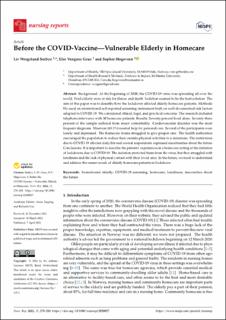| dc.contributor.author | Sørbye, Liv Wergeland | |
| dc.contributor.author | Grue, Else Vengnes | |
| dc.contributor.author | Hogeveen, Sophie | |
| dc.date.accessioned | 2022-04-22T12:06:06Z | |
| dc.date.available | 2022-04-22T12:06:06Z | |
| dc.date.created | 2022-04-21T09:17:13Z | |
| dc.date.issued | 2022 | |
| dc.identifier.citation | Nursing Reports. 2022, 12 (2), 270-280. | en_US |
| dc.identifier.issn | 2039-439X | |
| dc.identifier.uri | https://hdl.handle.net/11250/2992300 | |
| dc.description | This article is an open access article distributed under the terms and conditions of the Creative Commons Attribution (CC BY) license (https:// creativecommons.org/licenses/by/ 4.0/). | en_US |
| dc.description.abstract | Background: At the beginning of 2020, the COVID-19 virus was spreading all over the world. Frail elderly were at risk for illness and death. Isolation seemed to be the best solution. The aim of this paper was to describe how the lockdown affected elderly homecare patients.
Methods: We used an international self-reported screening instrument built on well-documented risk factors adapted to COVID-19. We considered ethical, legal, and practical concerns. The research included telephone interviews with 30 homecare patients.
Results: Seventy percent lived alone. Seventy-three percent of the sample suffered from major comorbidity. Cardiovascular disorder was the most frequent diagnosis. Nineteen (63.3%) needed help for personal care. Several of the participants were lonely and depressed. The homecare teams struggled to give proper care. The health authorities encouraged the population to reduce their outside physical activities to a minimum. The restrictions due to COVID-19 affected daily life and several respondents expressed uncertainties about the future.
Conclusions: It is important to describe the patients’ experiences in a homecare setting at the initiation of lockdowns due to COVID-19. The isolation protected them from the virus, but they struggled with loneliness and the lack of physical contact with their loved ones. In the future, we need to understand and address the unmet needs of elderly homecare patients in lockdown. | en_US |
| dc.language.iso | eng | en_US |
| dc.publisher | MDPI | en_US |
| dc.rights | Navngivelse 4.0 Internasjonal | * |
| dc.rights | Navngivelse 4.0 Internasjonal | * |
| dc.rights.uri | http://creativecommons.org/licenses/by/4.0/deed.no | * |
| dc.subject | Hjemmesykepleie | en_US |
| dc.subject | Homecare | en_US |
| dc.subject | Covid-19 | en_US |
| dc.subject | Ensomhet | en_US |
| dc.subject | Loneliness | en_US |
| dc.subject | Eldre | en_US |
| dc.subject | Old people | en_US |
| dc.subject | homebound | en_US |
| dc.subject | elderly | en_US |
| dc.title | Before the COVID-Vaccine — Vulnerable elderly in homecare | en_US |
| dc.type | Peer reviewed | en_US |
| dc.type | Journal article | en_US |
| dc.description.version | publishedVersion | en_US |
| dc.rights.holder | © 2022 by the authors. Licensee MDPI, Basel, Switzerland. | en_US |
| dc.subject.nsi | VDP::Helsefag: 800 | en_US |
| dc.subject.nsi | VDP::Health sciences: 800 | en_US |
| dc.source.pagenumber | 270-280 | en_US |
| dc.source.volume | 12 | en_US |
| dc.source.journal | Nursing Reports | en_US |
| dc.source.issue | 2 | en_US |
| dc.identifier.doi | 10.3390/nursrep12020027 | |
| dc.identifier.cristin | 2018067 | |
| cristin.ispublished | true | |
| cristin.fulltext | original | |
| cristin.qualitycode | 1 | |

